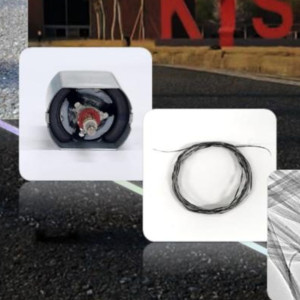World’s first metal-free motor could supercharge EVs and spacecraft


Researchers in South Korea have developed the world's first fully functional electric motor constructed entirely without metal components. This advancement, utilizing carbon nanotubes (CNTs) instead of traditional copper coils, represents a significant step toward ultra-lightweight transportation systems. The motor exhibits a 133% improvement in electrical conductivity and is 80% lighter than conventional designs.
"Whether it's electric vehicles, drones, or spacecraft, a common technical challenge for future transportation is lightweighting. Reducing the weight of a vehicle not only reduces energy consumption, but also increases battery efficiency and increases range," said the researchers in a press release. The motor, developed by a team at the Korea Institute of Science and Technology (KIST), operates effectively and has been shown to power a toy car at speeds exceeding half a meter per second.
"By developing a new concept of CNT high-quality technology that has never existed before, we were able to maximize the electrical performance of CNT coils to drive electric motors without metal," said Dr Dae-Yoon Kim of KIST. This innovation holds potential to reduce weight across various applications, from electric vehicles[1] to spacecraft, while maintaining performance.
Overcoming purity challenges
"CNTs are one-dimensional tube-shaped nanomaterials with carbon atoms arranged in a hexagonal honeycomb structure, which are known to be much lighter than ordinary metals, while at the same time possessing excellent electrical conductivity, mechanical strength, and thermal conductivity," added[2] the researchers. This development was made possible by a new purification process that solves a long-standing challenge of achieving the purity needed for carbon nanotubes to replace copper.
By employing the purification method, called the LAST (Lyotropic Liquid Crystal-Assisted Surface Texturing) process, researchers removed metal impurities that have historically affected nanotube technology while preserving the tubes' electrical properties. Electric motor coils conventionally use copper due to its high electrical conductivity[3]. However, copper's density, at 8.9 grams per cubic centimeter, contributes significantly to overall system weight.
Carbon nanotubes offer comparable conductivity at 1.7 grams per cubic centimeter, providing a potential for reducing motor weight by more than 80%. The main challenge has been contamination. During production, metal catalyst particles become embedded in the carbon nanotubes, which degrades their electrical performance.
The KIST team's method, called the LAST (Lyotropic Liquid Crystal-Assisted Surface Texturing) process, uses principles similar to the liquid crystal technology found in LCD screens. By dissolving the nanotubes in chlorosulfonic acid, the researchers created a liquid crystal state where the tubes self-align. When this solution is exposed to water, it generates hydrochloric acid that removes the iron catalyst impurities while leaving the carbon nanotube structures intact.
This process reduced metal contamination from an initial 12.7% to less than 0.8%.
Performance metrics and demonstrations
The purified carbon nanotube cables achieved an electrical conductivity of 7.7 megasiemens per meter. When built into a motor, the specific rotational velocity--a measure of performance per unit weight--was 1.06 times lower than an equivalent copper-based motor. The motor also operated continuously for 60 minutes under various power loads.
The team built a scale model car powered by their metal-free motor and tested it on asphalt roads. The vehicle traveled 10 meters in 25 seconds. While copper-based motors achieved higher absolute speeds in the tests (1.35 meters per second compared to 0.52 meters per second for the nanotube version), the carbon nanotube wires weighed 78.75 milligrams, significantly less than the 379.08 milligrams of equivalent copper wires.
"Based on the innovation of CNT materials, we will take the lead in localizing materials such as conductive materials for batteries, pellicles for semiconductors, and cables for robots," concluded Dr Kim.
References
- ^ electric vehicles (interestingengineering.com)
- ^ added (www.eurekalert.org)
- ^ high electrical conductivity (interestingengineering.com)